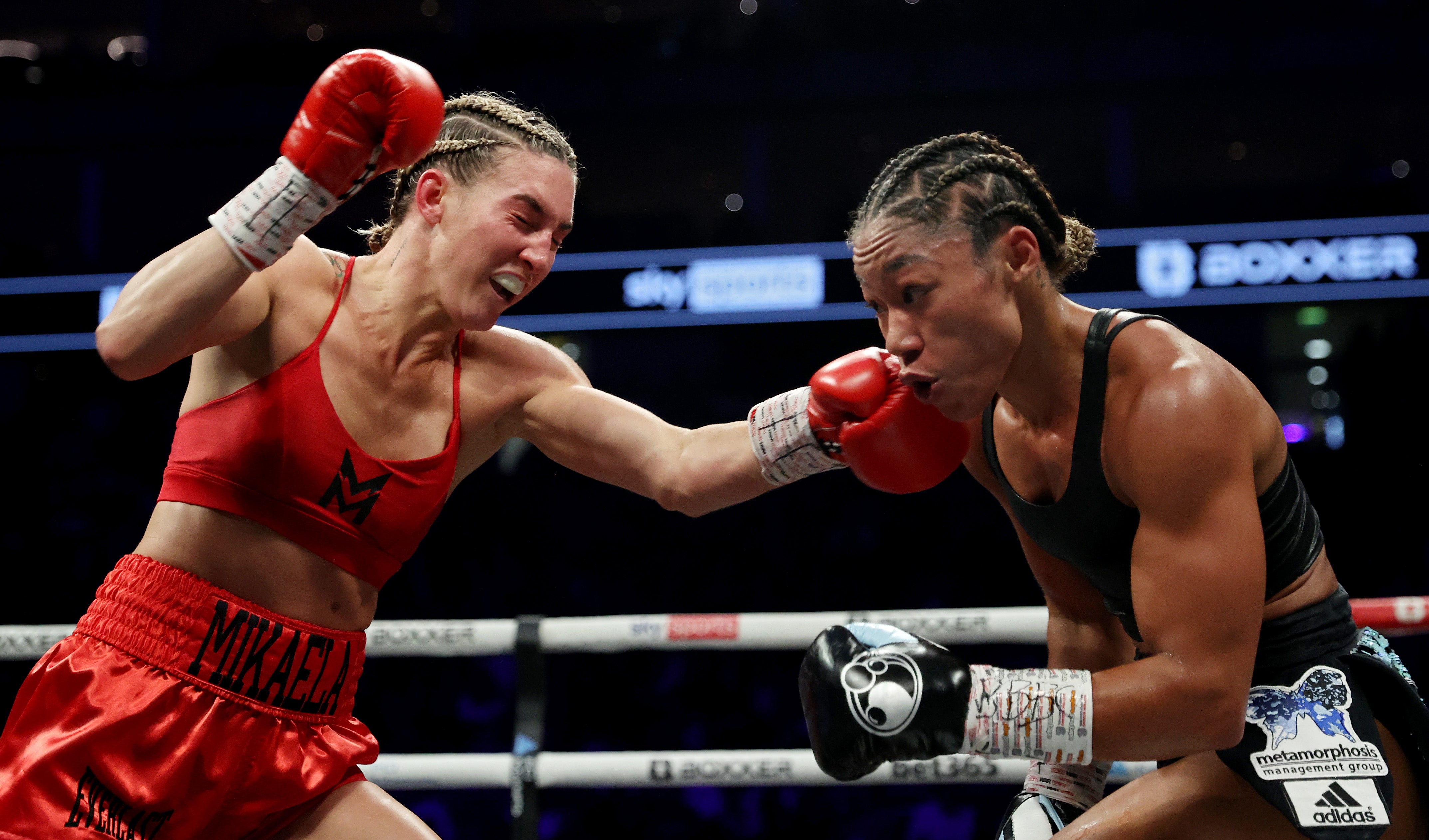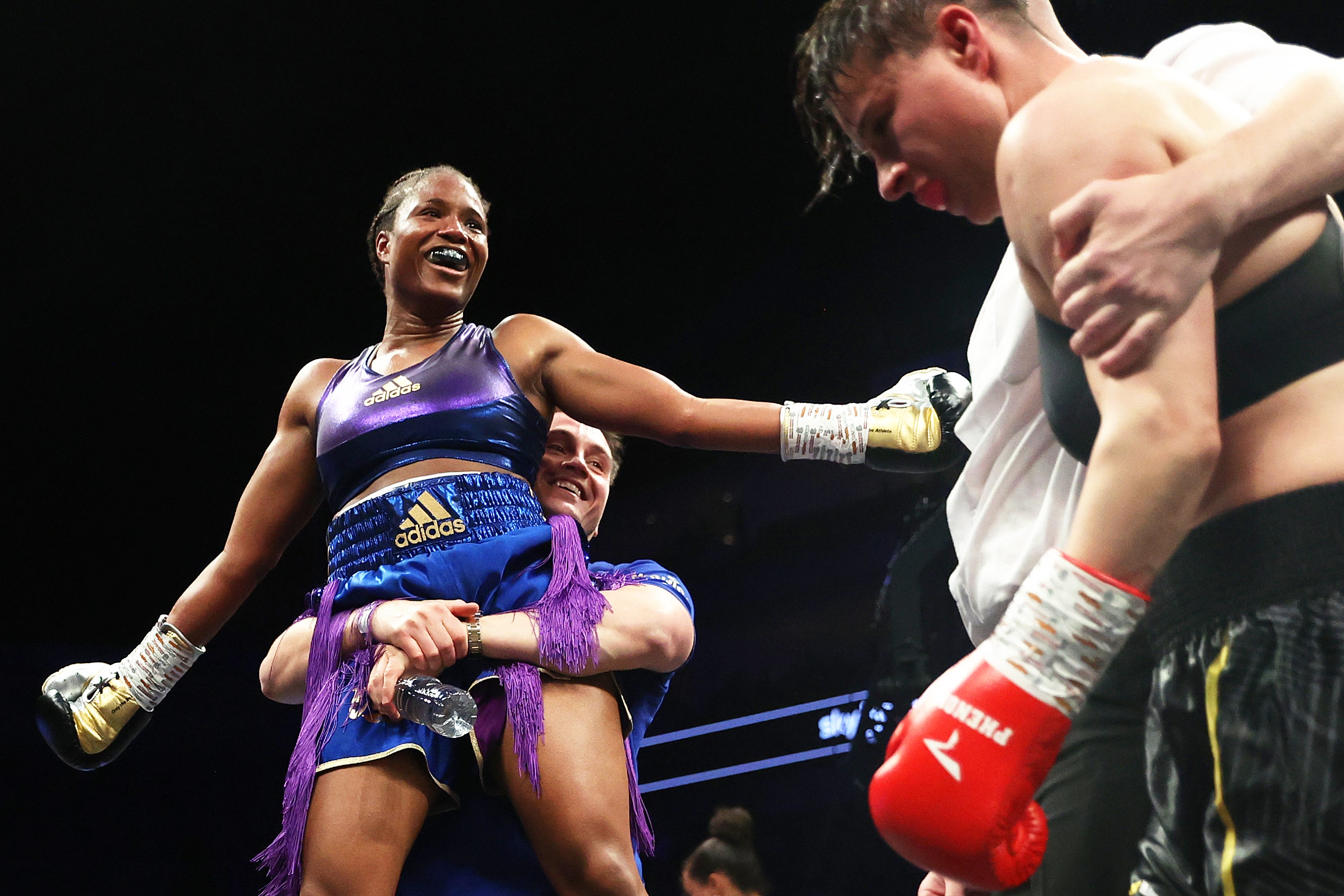‘Inclusive’ Shields vs Marshall event a window into future of women’s boxing
More than one-third of the O2 Arena crowd was female on a landmark night for women’s boxing

On Saturday night, as Claressa Shields and Savannah Marshall dueled with destiny and one another under the famous dome of the O2 Arena, the structure reverberated in a familiar fashion – but with a curious cadence.
Not two minutes into the main event in London, Shields began to pierce Marshall’s defence with jagged hooks, grazing the volume dials in the O2 Arena along the way as those in attendance contested their own duel – some roaring on the American and others pleading with Marshall to rally. The pitch of those shouts, however, was distinct from the usual cacophony at such events. In the final round of the scheduled 10, as Marshall and Shields brutalised one another’s bodies in an attempt to put each other down and this rivalry to bed, the sound was as clear as it had been all evening: it was carried, in large part, by a sizeable segment of devoted female fans.
“Ticketmaster reported 35 per cent of the sales were female, as opposed to less than 5 per cent on a normal men’s boxing event,” promoter Ben Shalom tells The Independent, two days removed from Shields’ seismic decision victory and vengeance against her British rival.
“It was a better crowd, it seemed more inclusive, it seemed like the sport had taken a step forward,” adds the Boxxer chief, who put together an all-female card that also saw Alycia Baumgardner and Mikaela Mayer spill bad blood on the black canvas.
It was a night when women, even when battling against each other, worked together inside the ring to open a window into what boxing can be for a group of fighters who have long been denied opportunities and plaudits that are rightfully theirs. Even outside the ring in the O2 Arena, the women in attendance were working with those between the ropes, too.
“Representation is everything,” Shields tells The Independent, joining Shalom to discuss Saturday’s landmark card, whose 2 million viewers made it the most-watched women’s sporting event in Sky Sports history. “If I had a Claressa Shields growing up, of course I would have been better. I would know the game and wouldn’t have to work as hard.
“I’m creating a blueprint for women on how to become a world champion, how to captivate a crowd, but God chose me to be as great as I can; I am the greatest woman of all time.”
Given that the unbeaten Shields became undisputed middleweight champion and confirmed her “GWOAT” nickname while avenging an amateur loss to Marshall, it is an almost frightening thought that there could exist a world in which the 27-year-old would be an even fiercer competitor. Almost frightening, but Shields, Marshall, Baumgardner, Mayer, Caroline Dubois and the other women who fought on Saturday are sculpting such a world for whoever will grow into the next generation’s great – and that is a wholly encouraging thought.

“In terms of representation,” Shalom adds, “when Claressa started, it was more difficult to accept women’s boxing. She’s had a dream without somebody to look up to. Caroline Dubois now, she looks up to Claressa, and without her being here, [Dubois] wouldn’t be able to see that path and how far she can go.”
Enjoy 185+ fights a year on DAZN, the Global Home of Boxing
Never miss a fight from top promoters. Watch on your devices anywhere, anytime.
ADVERTISEMENT. If you sign up to this service we will earn commission. This revenue helps to fund journalism across The Independent.
Enjoy 185+ fights a year on DAZN, the Global Home of Boxing
Never miss a fight from top promoters. Watch on your devices anywhere, anytime.
ADVERTISEMENT. If you sign up to this service we will earn commission. This revenue helps to fund journalism across The Independent.
For inspiration, the 21-year-old Dubois has looked to Shields and the American’s multiple world titles across three weight classes – as well as the GWOAT’s two Olympic gold medals. But the Briton also has role models in compatriot Marshall, who reigned as WBO middleweight champion until last weekend; unified super-featherweight champion Baumgardner and the American’s countrywoman Mayer; and the likes of world champions Katie Taylor and Amanda Serrano, whose Madison Square Garden main event in April rivals Saturday’s headline bout for the status of boxing’s biggest ever women’s bout.
That said, Shields vs Marshall and Taylor vs Serrano will go down as two of the biggest fights in the sport on the whole – not just on the women’s side.
“Women’s boxing can co-exist with men’s boxing, it’s not a problem,” Shields insists. “When you put the best female fighters on a card, it’ll have a great outcome. I just want every network to include women. Some of us deserve the big fights.”
And while the all-female card at the O2 Arena captured the imagination of female fight fans and the boxing world in general, Shalom has said such events will not always be necessary to brighten the spotlight on women.

“There was an opportunity to showcase women’s boxing on the biggest scale,” says the 29-year-old. “It’s not a case that it has to be women’s cards and men’s cards; it was more to show the power of women’s boxing. It’s not reliant on men’s boxing, it’s a sport of its own, [but] in future when women are on men’s cards, they won’t be seen as a supporting act and they won’t be seen as a bit-part player.
“Look what women’s boxing can do without any reliance. We were told Shields vs Marshall would need a heavyweight men’s fight to help it sell. On occasions, we might do all-women cards, but these athletes have the potential to headline bills, become superstars. They won’t just be floating around on undercards. The blueprint is there, women’s boxing is equal to men’s as [it’s] doing things that even the men’s sport couldn’t do in selling out the O2.”
Shields, meanwhile, advocates women partaking in 12 three-minute rounds, rather than the 10 two-minute frames that currently constitute top-level female fights. The Olympian does, however, wish to see such a change implemented in a gradual, “safe” manner.
“To move women’s boxing forward, we’ll have to fight the same amount of time as the men,” Shields says, “but I think we should go to 12 two-minute rounds [first]. It’s safer; to jump to 36 minutes is dangerous, but from 20 to 24 minutes... get us used to fighting 12 rounds. If we move forward, we can go to three-minute rounds in a few years. It’s safer for women; we’ve been boxing two-minute rounds forever. Eventually, it will be 12 three-minute rounds, though.”
It is, as Shields suggests, just a matter of time, which reflects the growth of women’s boxing on the whole. But fans – female and otherwise – are no longer content with catching that reflection in the window. They want to be present as women bust open the door into a brave new world.
Join our commenting forum
Join thought-provoking conversations, follow other Independent readers and see their replies
Comments


Bookmark popover
Removed from bookmarks